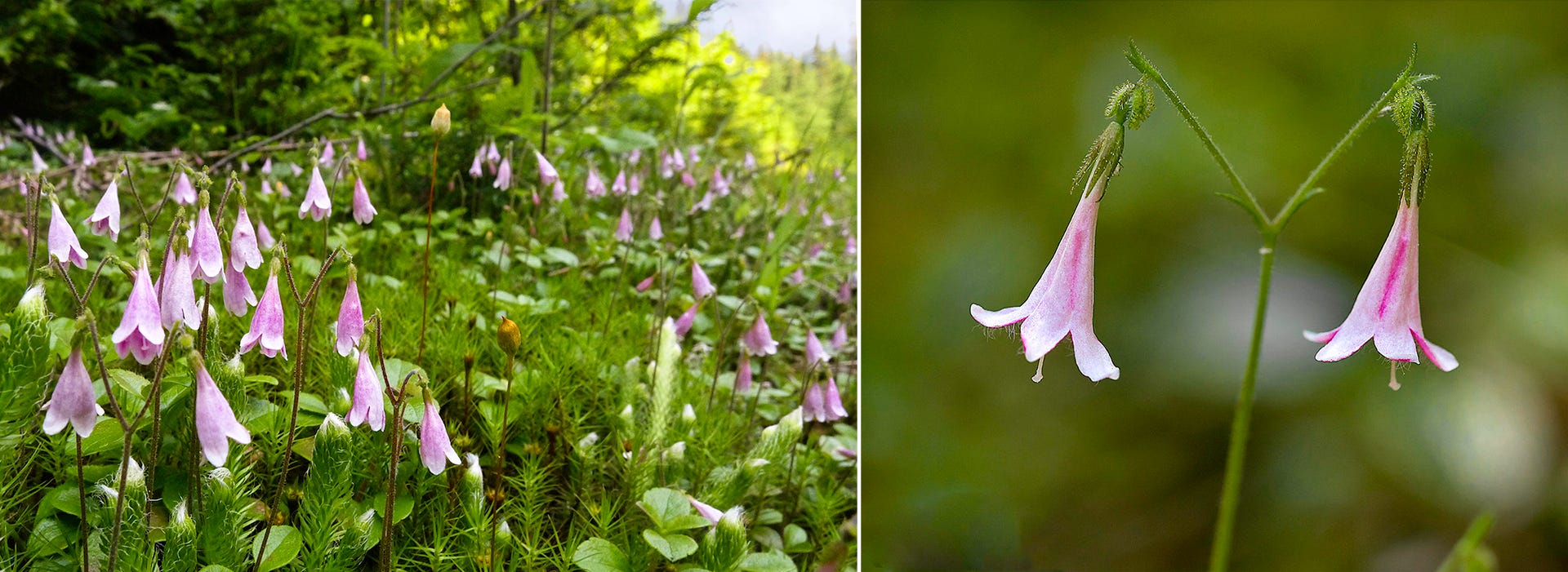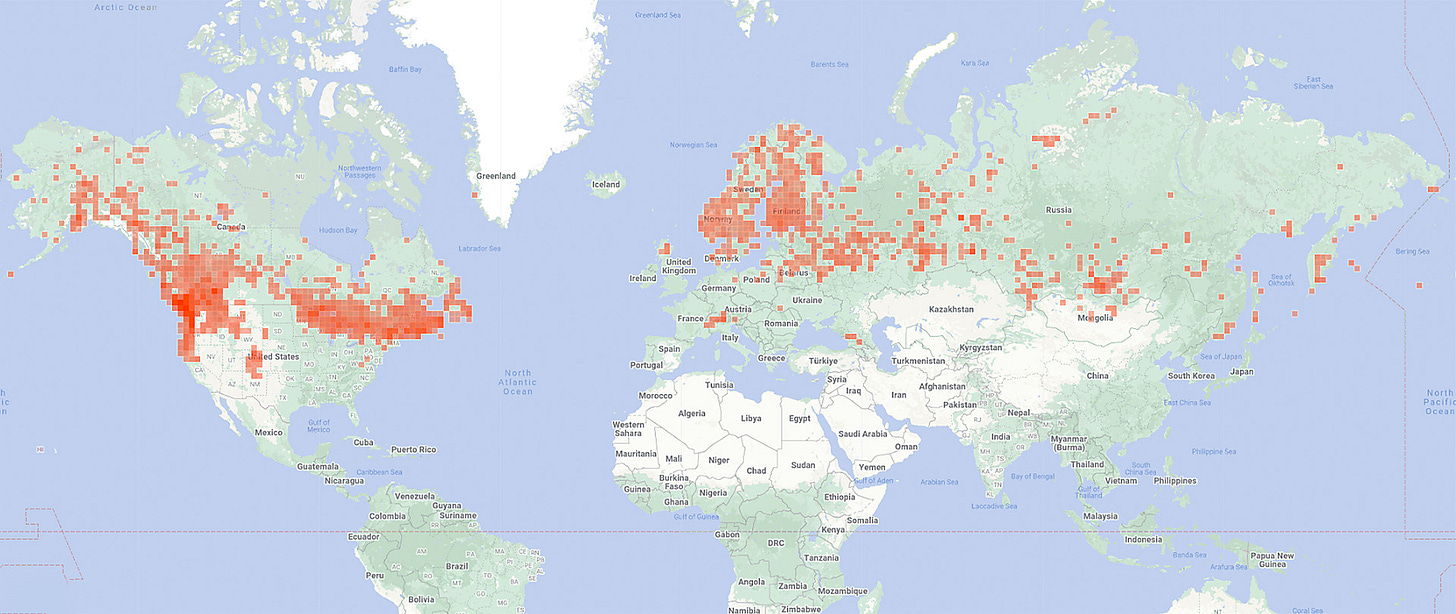A Substack Field Trip for Twinflower
Let's find this elegant plant now beginning to bloom in northern forests around the world. We'll share our photos and reflections here at Chasing Nature.
DURABLE AND GRACEFUL, here is a plant that knows nothing of intolerance or warfare. It blooms all the same in the forests of Ukraine and the woodlands of Russia, amid the tyranny of North Korea and the freedom of Denmark, in right-wing Wyoming and here in lefty Vermont.
If there can be a world citizen now coming into bloom in the north it is Twinflower (Linnaea borealis). Beyond its charm, Twinflower’s pedigree is perhaps best expressed in its scientific name, which requires no scholarship in Latin to decipher.
The genus Linnaea honors Carl Linnaeus, the Swedish biologist who formalized the way scientists name organisms. Twinflower was his favorite plant, and was subsequently assigned to a new genus bearing Linnaeus’ name. It is the only species in the genus.
Borealis is the Latin derivation of Boreas, the Greek god of the north wind. And Twinflower is indeed a northerner. Put a planetary-sized donut over the North Pole, and you would cover the world’s Twinflower plants, a distribution going by the lovely term “circumboreal.”
Now is when Twinflower blooms. So let us northern readers of Chasing Nature find and celebrate this plant together. We’ll post our photos of Twinflower in a Substack Chat that I’ve already launched for us.
To join this outing, first find your Twinflower, which is for the most part a plant of cool, coniferous (evergreen) woods. If you’ve got spruce and fir in the north (not necessarily pines or hemlock), you may not be far from Twinflower (although I find it in mixed woods and sometimes in deciduous-dominated woods). To guide you, here is a map of 18,000 Twinflower sightings (with photos) around the world thanks to the amazing iNaturalist. (Zoom for individual records near you.)
Next, look down. Twinflower is a woody, semi-evergreen plant that creeps among mosses and lichens on the forest floor. Its pair of dangling pink flowers on a stalk about four or so inches tall are unmistakeable. Let those flowers bring you to your knees (including for a photograph to share).
Depending on latitude and elevation, Twinflower blooms in June, July and into August. If it is not yet blooming, it is easily overlooked among other greenery on the forest floor. So seek oval-to-roundish, leathery leaves (1-2 cm in diameter), also in pairs and situated opposite each other along the creeping stem. You can see those leaves among the moss in my image above, but this view of the 18,000 iNaturalist records features photographs of this plant in all its manifestations, including in bunches where the opposite leaves are less obvious. To be sure, especially if you’re in the wrong habitat (deciduous woods and pines, for example) you’ll find Twinflower imposters. But even if it’s not yet blooming, Twinflower should now feature a Y-shaped stem bearing its two flowers in bud.
Twinflower knows no international borders. It is our shared heritage in the north no matter what our beliefs. Here at Chasing Nature, we are a community of more than 2,400 readers (and one humble writer) living in 72 countries and 49 U.S. states. Let those of us fortunate to live in the company of Twinflower share it with the rest of the world. And maybe I’ll find a “circumaustral” plant that readers in the southern hemisphere can share with the rest of us this December.
Before details of the chat, I leave you with haiku from my dear friend Kristen Lindquist, who has written a haiku virtually every day for more than a decade, and shares them with subscribers like me.
sun in Gemini . . . where two trails diverge twinflowers
The Twinflower Chat
The best way for us to share our Twinflower images is in a Substack Chat. So I’ve launched a new thread in Chat with a Twinflower image from here in Vermont. To see shared Twinflower images from readers or to post your own photo, you’ve got two options:
Your Internet Browser — For those of you who read Substack writers in your browser (and not your phone), as I do, you should be able to find our Twinflower Chat here. You can upload your photo and comments, and click to like or comment on other readers’ Twinflower observations.
The App — To use the Substack app for the chat:
If you don’t use it already, download the app by clicking this link or the button below.
Open the app and tap the Chat icon (the squarish bubbles in the bottom bar). If you’re a subscriber, you should see the Chasing Nature chat (and perhaps chats from other Substack writers you read).
Once you’ve located my chat about Twinflower, post your photo there. You can also react (with emojis) to any other photos or add comments of your own (including by pressing and holding an image or comment).
If you’d like to stay engaged with new images and comments and reactions during the chat, consider turning on push notifications. (I myself don’t use push notifications.)
Finally, if you’re reading this very post in the app or in an email on your phone with the app already installed, the “Join chat” button below should send you directly to our chat. Or so I’m told.







I couldn't find the photos others have posted, but I way like yours. It gave me a particular pleasure to study the range of this beautiful species and to find it so generously native around the top of the globe. And yes, it's been found in Iowa, too, though not where I live and write, in the southeast corner.
When I was small I called them “spider’s street lamps”.